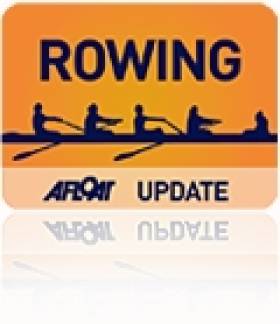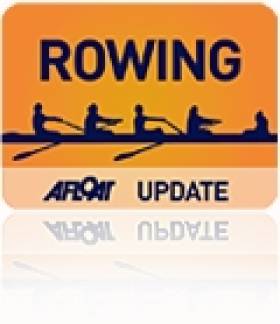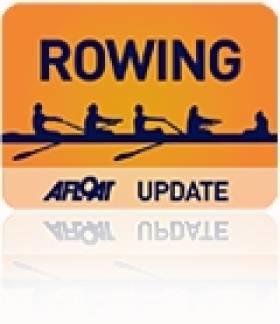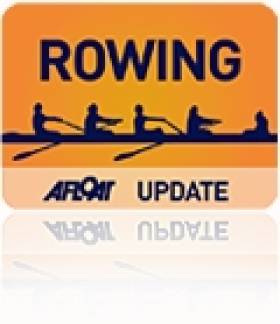Displaying items by tag: Dukarska
#Rowing: Ireland rower Monika Dukarska will be sponsored by foreign exchange specialist FEXCO this season as she and rowing partner Leonora Kennedy target qualification for the Ireland pair for the Olympic Games next year. FEXCO is a multinational finance and business solutions provider with operations in 28 countries. Its head office is in Killorglin in Kerry.
The Ireland crew of Dukarska and Kennedy will qualify the pair for Rio 2016 if they finish in the top 11 at the World Rowing Championships in Aiguebelette in France in September.
Dukarska, who is 24, started rowing at the Killorglin Rowing Club shortly after moving to Ireland from Poland when she was 16.
Shane Kavanagh, the group marketing director of FEXCO, said: “We are delighted to be working with Monika during her training for the Olympics, and it would be great to see a women’s pair qualify and make Irish history.
“Monika is an extremely talented athlete, with an incredible amount of drive and ambition. This is clear through her dedication to rowing throughout her school years, as well as receiving a first class bachelors and masters degree, while competing at a professional level. We look forward to supporting Monika on the road to Rio.”
Dukarska said: “It’s great to have FEXCO behind me during the Rio qualifying rounds.
“Our success at the Memorial Paolo d’Aloja Regatta was a great start to the season. Despite being my first international regatta in the women’s pair event, my partner Leonora Kennedy and I managed to take home the gold in both races. We had a good result last week in Poznan finishing ninth in the European Championships. I’m glad to be home in Ireland now and training harder than ever for September’s qualifier.”
#ROWING: Sinéad Jennings finished second in her B Final, eighth overall in the lightweight single sculls at the European Rowing Championships in Poznan, Poland, this morning. Denmark’s Runge Holmegaard led down the course, but Jennings stayed in touch and pushed at the end.
The women’s pair of Leonora Kennedy and Monika Dukarska finished third in their repechage (ninth overall). The Ireland crew were at the head of the field for much of the race, but the Czechs took over in the final quarter, with Spain testing them in the closing stages.
European Rowing Championships, Poznan, Day Two (Irish interest)
Women
Pair, B Final (Places 7 to 12): 1 Czech Republic 7:16.56, 2 Spain 7:17.04, 3 Ireland (L Kennedy, M Dukarska) 7:20.37
Lightweight Single Sculls, B Final (Places 7 to 12): 1 Denmark (R Holmegaard) 7:40.62, 2 Ireland (S Jennings) 7:45.64, 3 Netherlands 7:49.94.
#Rowing: Ireland’s men’s and women’s lightweight double sculls qualified for A Finals at the European Rowing Championships in Poznan, Poland this morning. The O’Donovan brothers, Paul and Gary, raced very well, putting themselves into contention for a crucial third place in the middle of the race, and then securing it with a good closing 500 metres. Britain’s William Fletcher and Richard Chambers won well. Claire Lambe and Denise Walsh had to come through an exciting finish to secure third. Poland won, with Denmark, Ireland and Russia taking the second to fourth placings. Ireland were just .17 of a second ahead of Russia on the line.
The Ireland women’s pair of Monika Dukarska and Leonora Kennedy finished fifth in their semi-final, and Sinéad Jennings fourth in the semi-final of the lightweight women’s single sculls.
European Rowing Championships, Poznan, Day Two (Irish interest)
Men
Lightweight Double Sculls – A/B Semi-Final One (Three to A Final; rest to B Final): 1 Britain (R Chambers, W Fletcher) 6:16.83, 2 Norway 6:21.02, 3 Ireland (P O’Donovan, G O’Donovan) 6:22.89; 4 Czech Republic 6:27.58, 5 Austria 6:31.75, 6 Greece 6:41.41.
Women
Pair – A/B Semi-Final One (Three to A Final; rest to B Final): 1 Netherlands 7:05.80, 2 Romania 7:09.40,3 France 7:13.10; 4 Czech Republic 7:14.97, 5 Ireland (L Kennedy, M Dukarska) 7:30.00, 6 Germany 7:34.45.
Lightweight Double Sculls – A/B Semi-Final One (Three to A Final; rest to B Final): 1 Poland 6:58.39, 2 Denmark 7:02.24, 3 Ireland (C Lambe, D Walsh) 7:02.82; 4 Russia 7:02.99, 5 Romania 7:03.82, 6 Czech Republic 7:17.73.
Lightweight Single Sculls – A/B Semi-Final One (Three to A Final; rest to B Final): 1 Russia 7:42.99, 2 Lithuania 7:44.09, 3 Britain 7:44.62; 4 Ireland (S Jennings) 7:45.99, 5 Austria 7:58.39, 6 Latvia 8:02.81.
#ROWING: The first six races of the Ireland challenge at the European Rowing Championships resulted in three direct qualifications for A/B semi-finals and three boats set for repechages. Sinéad Jennings gave Ireland a good start by finishing second of three qualifiers in the lightweight single sculls. The women’s pair of Monika Dukarska and Leonora Kennedy were one place further back in a race won well by the Nethlerlands, but also qualified. The lightweight women’s double of Claire Lambe and Denise Walsh also took the third qualification place in their race.
The lightweight men’s double of Paul and Gary O’Donovan needed to finish in the top two in their heat – and they came close with a fast second 1,000 metres. France, the Czech Republic and Greece set the first-half pace. Ireland passed Greece and closed to within one second of the Czech Republic, who took the second qualification place behind France. The Ireland women’s pair were fifth and last in their heat, as was the lightweight men’s four.
European Rowing Championships, Poznan, Day One (Irish interest)
Men
Lightweight Four – Heat One (First Three Directly to A/B Semi-Finals; rest to Repechage): 1 Britain 6:07.57, 2 Germany 6:09.56, 3 Russia 6:09.72; 4 Austria 6:25.53, 5 Ireland (M Bailey, A English, M O’Donovan, S O’Driscoll ) 6:38.91.
Lightweight Double Sculls – Heat Three (Two Directly to A/B Semi-Finals; rest to Repechage): 1 France 6:20.55, 2 Czech Republic 6:27.16; 3 Ireland (P O’Donovan, G O’Donovan) 6:28.06, 4 Greece 6:41.16, 5 Poland 7:04.83.
Women
Pair – Heat Three (First Three Directly to A/B Semi-Finals; rest to Repechage): 1 Netherlands 7:12.68, 2 Spain 7:16.31, 3 Ireland (L Kennedy, M Dukarska) 7:17.07; 4 Poland One 7:17.84.
Double Sculls (First Three Directly to A/B Semi-Finals; rest to Repechage): 1 Poland 6:49.73, 2 Britain 6:53.58, 3 Serbia 6:55.67; 4 Romania 7:06.54, 5 Ireland (H Hannigan, L Dilleen) 7:24.08.
Lightweight Double Sculls (First Three Directly to A/B Semi-Finals; rest to Repechage): 1 Poland 7:06.62, 2 Netherlands 7:09.30, 3 Ireland (C Lambe, D Walsh) 7:15.74; 4 Ukraine One 7:28.07.
Lightweight Single Sculls – Heat Three (First Three Directly to A/B Semi-Finals; rest to Repechage): 1 Germany 7:47.03, 2 Ireland (S Jennings) 7:47.61, 3 Denmark 7:49.41; 4 Poland 8:03.59.
#ROWING: Leonora Kennedy and Monika Dukarska will team up in a double scull for Ireland at the Memorial Paolo d’Aloja Regatta in Piediluco in Italy on April 10th to 12th. Lisa Dilleen, who partnered Kennedy in the pair last season, has been ill, and Helen Hannigan, who teamed up with Dukarska in the double, is recovering from injury. The lightweight men’s double of Gary and Paul O’Donovan and the lightweight women’s double of Claire Lambe and Denise Walsh, along with single sculler Sanita Puspure have also been given the nod after the second day of the final Ireland Trial at the National Rowing Centre in Cork. Siobhán McCrohan will compete in the lightweight single sculls.In Sunday's testing, the under-23 lightweight four were faster than the nominated senior lightweight four.
Ireland Final Trial: Selected Results (weighted for class of crew)
Saturday
Men
Fours, Double Sculls: 1 P O’Donovan, G O’Donovan (lightweight double) 6:59.0, 2 M O’Donovan, S O’Driscoll, M Bailey, A English (lightweight four) 6:57.30, Four (Coughlan) 6:56.52.
Lightweight Single Sculls: 1 F McCarthy 8:24.28, 2 A Burns 8:25.04, 3 S Toland 8:28.95.
Pararowing: T Kelly 6:09.01, 2 K Doherty 6:06.17.
Women
Doubles/Pairs: 1 D Walsh, C Lambe (lightweight double) 7:46.35, 2 M Dukarska, L Kennedy (pair) 8:00.26, 3 A Casey, E Hegarty (jun double) 8:17.29.
Single Sculls: 1 A Keogh 8:50.56. 2 O Finnegan 9:00.95, 3 B O’Brien (NUIG) 9:02.76.
Lightweight Single: 1 S McCrohan 8:44.47, 2 S Quinn 9:04.35.
Sunday
Fours, Quadruple Sculls, Double Sculls: 1 P O’Donovan, G O’Donovan (lightweight double) 6:41.34, 2 D O’Malley, L Seaman, S Mulvaney, L Keane (under-23 lightweight men’s four) 6:33.21, 3 S O’Driscoll, M Bailey, A English, M O’Donovan (lightweight men’s four) 6:37.49.
Pairs, Double Sculls, Single Sculls: 1 D Walsh, C Lambe (lightweight women’s double) 7:28.48, 2 M Dukarska, L Kennedy (heavyweight pair) 7:42.14, J Keohane (heavyweight single) 7:45.71.
Pairs, Single Sculls: 1 S Toland (lightweight) 7:44.72, 2 O’Connor, Carmody (lightweight pair) 7:19.94, McCarthy (lightweight) 7:46.63.
Double Sculls: 1 S McKeown, E Rowan (heavyweight double) 6:50.93, 2 P Doyle, M Rowan (heavyweight double) 7:04.43, 3 Munnelly, Byrne (heavyweight double) 7:10.56
Women’s Single Sculls: 1 S Puspure 7:59.07, 2 S McCrohan 8:21.93, 3 A Keogh 8:33.06.
Pararowing: 1 K Doherty 6:01.51, 2 T Kelly 6:12.62.
New Ireland Double 11th at World Rowing Championships
#ROWING: Ireland’s women’s double of Monika Dukarska and Helen Hannigan (Walshe) finished fifth in their B Final at the World Rowing Championships in Amsterdam this morning. The race was won by the Netherlands, who got out in front early and held off challenges by Germany and Russia. Ireland started well but slipped back to sixth position. However, the crew dug in and won a battle with Denmark for fifth. They finished well, closing up on fourth-placed Ukraine coming up to the line. The placing puts Ireland 11th in this Olympic-class event.
World Rowing Championships, Day Eight (Irish interest, selected results):
Women
Double Sculls – B Final (Places 7 to 12): 1 Netherlands 5:06.20, 2 Russia 5:09.13, 3 Germany 5:09.17, 4 Ukraine 5:14.12, 5 Ireland (H Hannigan, M Dukarska) 5:16.36, 6 Denmark 5:16.55.
#ROWING: Ireland’s new women’s double of Helen Hanningan (neé Walshe) and Monika Dukarska made a significant breakthrough at the World Rowing Championships in Amsterdam today, qualifying for the A/B Semi-Finals. The target was a place in the top two of their repechage. Romania made the early pace, with Ireland and the United States joining them in the challenge. By the closing stagest the US had their place sewn up, while Dukarska and Hannigan took out Romania to enter the top 12 crews at the Championships.
World Rowing Championships, Day Four (Selected Results; Irish interest)
Men
Lightweight Single Sculls – Quarter-Final (First Three to A/B Semi-Finals; rest to C/D Semi-Finals): 1 Germany (L Hartig) 7:13.67, 2 Ireland (P O’Donovan) 7:14.76, 3 Denmark (S Jensen) 7:33.91; 4 Azerbaijan 7:25.84, 5 Russia 7:33.91, 6 Algeria 7:43.76.
Women
Double Sculls – Repechage Three (First Two to A/B Semi-Final: rest to C/D Semi-Final): 1 United States (M O’Leary, E Tomek) 7:18.10, 2 Ireland (H Hannigan, M Dukarska) 7:21.14; 3 Romania 7:22.87, 4 Estonia 7:48.85.
#ROWING: The men’s junior coxed four was the standout race of the morning session at the Irish Rowing Championships at the National Rowing Centre in Cork today. It took a photo finish to confirm Cork Boat Club’s win over Presentation, with Portora also disputing the lead right to the last 50 metres.
Cork Boat Club also took the women’s junior single sculls title through Oisin Forde, who won a fine battle with Jasmine English of Belfast Boat Club. Forde is from Torrevieja in Spain and with her sister Dervla, who was third, will represent Ireland at the Coupe de la Jeunesse next month.
The men’s senior pair final gave Mark O’Donovan and Niall Kenny of UCD a chance to show why they are in the frame to represent Ireland at the World Championships this year, while a former international Fiola Foley partnered a current one, Monika Dukarska to win the women’s intermediate doubles title.
Irish Rowing Championships, National Rowing Centre, Cork (Selected Results; Finals)
Men
Eight – Intermediate: 1 Trinity 5:46.25, 2 NUIG 5:50.28, 3 UCD 5:56.96.
Four, coxed – Junior: 1 Cork BC 6:35.99, 2 Presentation 6:36.22, 3 Portora 6:38.08.
Pair – Senior: 1 UCD (M O’Donovan, N Kenny) 6:46.05, 2 NUIG 6:49.95, 3 Commercial B 7:00.16.
Sculling
Single: Lee (D O’Sullivan) 7:31.80, 2 St Michael’s (P O’Connor) 7:36.24, 3 Belfast BC (A Murray) 7:39.44.
Women
Eight – Novice: 1 Queen’s 7:19.74, 2 Trinity 7:55.75.
Sculling, Double – Intermediate: 1 Killorglin (F Foley, M Dukarska) 7:17.17, 2 Commercial 7:20.83, 3 Skibbereen 7:39.99.
Single – Junior: 1 Cork BC (O Forde) 8:06.14, 2 Belfast BC (J English) 8:07.11, 3 Commercial B 7:00.16.
Moran and Dukarska Miss out at Aiguebelette Rowing
#ROWING: Ireland’s Monika Dukarska and Eimear Moran had to settle for missing out on a semi-final place at the World Cup Regatta in Aiguebelette in France. The Ireland double scull was in with a chance of taking the top-three place they needed until the final third of the race. John Keohane was off the pace in his repechage of the men’s single scull.The Corkman finished fourth when a top-two place would have taken him through to the A/B semi-finals.
World Cup Regatta, Aiguebelette, France, Day One (Selected Results, Irish interest)
Men
Single Sculls – Heat One (Time Trial; First Directly to A/B Semi-Finals; rest to Repechage); 1 Cuba (A Fournier Rodriguez) 6:48.06; 2 Canada 6:55.45, 3 Finland 6:59.39, 4 United States 7:06.59, 5 Ireland (J Keohane) 7:12.69, 6 Hungary 7:17.37. Repechage One (Two to A/B Semi-Finals): 4 Keohane 7:39.38.
Lightweight Single Sculls – Heats (Time Trials; First Two Directly Through to A/B Semi-Finals; rest to Repechage) – Heat One: 1 China (Tiexin Wang) 7:02.36, 2 France (D Piqueras) 7:07.64; 5 Ireland Two (M O’Donovan) 7:20.78
Heat Three: 1 Ireland One (P O’Donovan) 7:11.34, 2 Britain (Z Lee-Green) 7:15.60.
Repechage One (First Two to A/B Semis; 3-5 to C Final): 4 Ireland Two (O’Donovan) 7:37.56.
Women
Pair – Heat Two (Time Trial; First Three to A/B Semi-Finals; rest to Repechage): 1 Canada (N Mastracci, S Grainger) 7:13.29, 2 United States Two (G Luczak, C Lind) 7:13.87, 3 Ireland (L Kennedy, L Dilleen) 7:18.15; 4 Germany Two 7:32.77, 5 China Two 7:37.06.
Double Sculls – Heat Three (Time Trial; First Three Directly to A/B Semi-Finals; rest to Repechage): 1 Belarus (E Karsten, Y Bichyk) 6:51.94, 2 Britain (F Houghton, V Thornley) 6:54.71, 3 China (Yuwei Wang, Weiwei Zhu) 6:57.09; 4 France 7:07.40, 5 Ireland (M Dukarska, E Moran) 7:12.42. Repechage (Three to A/B Semi-Final): 5 Dukarska, Moran 7:40.13.
Lightweight Double Sculls – Heat Two (Time Trial; First Two Directly to A/B Semi-Finals; rest to Repechage): 1 Britain One (I Walsh, K Copeland) 7:02.44, 2 United States (D Karz, M Sechser) 7:07.21; 3 Ireland (C Lambe, D Walsh) 5:21.89, 4 Mexico Two 7:20.55, 5 Belarus 7:20.95. Repechage (First Two to A/B Semi-Finals; 3-5 to C Final): 1 Brazil (B Cardoso, F Beltrame) 7:24.44, 2 Ireland (Lambe, Walsh) 7:25.65; 3 Poland 7:27.13, 4 Belarus 7:33.59, 5 Czech Republic 7:37.94, 6 Mexico One 7:46.68.
Single Sculls – Heat Three (Time Trial; First Two directly to A/B Semi-Finals; rest to Repechage): 1 China (Jingli Duan) 7:30.54, 2 Ireland (S Puspure) 7:34.63; 3 Switzerland 7:35.99, 4 France 7:37.79, 5 Zimbabwe 7:41.57, 6 Croatia 7:42.46.
Pararowing – Arms and Shoulders Men’s Single Sculls – Heat Two (First to A Final; rest to Repechage): 5 Ireland (T Kelly) 5:48.38. Repechage Two (First two to A Final): 4 Kelly 6:06.18.
Puspure Secures Semi-Final Place at World Cup Rowing
#ROWING: Sanita Puspure marched into the A/B Semi-Finals at the World Cup Rowing regatta at Aiguebelette in France today. First or second in her heat, which was run as a time trial, was enough to secure qualification for the Ireland sculler. She matched the pace of Duan Jingli of China for much of the 2,000 metres, but at the end the Chinese won, with Puspure taking a clear second.
Mirka Knapkova of the Czech Republic and Emma Twigg of New Zealand won the other heats – with Twigg the fastest winner by over four seconds.
There was only ever going to be one man to win John Keohane’s heat of the men’s single scull: Angel Fournier Rodriguez of Cuba dominated the time trial and took the only direct qualification place. Keohane finished fifth of the six starters.
The Ireland women’s double of Monika Dukarska and Claire Lambe finished fifth of five in their heat.
World Cup Regatta, Aiguebelette, France, Day One (Selected Results, Irish interest)
Men
Single Sculls – Heat One (Time Trial; First Directly to A/B Semi-Finals; rest to Repechage); 1 Cuba (A Fournier Rodriguez) 6:48.06; 2 Canada 6:55.45, 3 Finland 6:59.39, 4 United States 7:06.59, 5 Ireland (J Keohane) 7:12.69, 6 Hungary 7:17.37.
Lightweight Single Sculls – Heats (Time Trials; First Two Directly Through to A/B Semi-Finals; rest to Repechage) – Heat One: 1 China (Tiexin Wang) 7:02.36, 2 France (D Piqueras) 7:07.64; 5 Ireland Two (M O’Donovan) 7:20.78
Heat Three: 1 Ireland One (P O’Donovan) 7:11.34, 2 Britain (Z Lee-Green) 7:15.60.
Women
Pair – Heat Two (Time Trial; First Three to A/B Semi-Finals; rest to Repechage): 1 Canada (N Mastracci, S Grainger) 7:13.29, 2 United States Two (G Luczak, C Lind) 7:13.87, 3 Ireland (L Kennedy, L Dilleen) 7:18.15; 4 Germany Two 7:32.77, 5 China Two 7:37.06.
Double Sculls – Heat Three (Time Trial; First Three Directly to A/B Semi-Finals; rest to Repechage): 1 Belarus (E Karsten, Y Bichyk) 6:51.94, 2 Britain (F Houghton, V Thornley) 6:54.71, 3 China (Yuwei Wang, Weiwei Zhu) 6:57.09; 4 France 7:07.40, 5 Ireland (M Dukarska, E Moran) 7:12.42.
Lightweight Double Sculls – Heat Two (Time Trial; First Two Directly to A/B Semi-Finals; rest to Repechage): 1 Britain One (I Walsh, K Copeland) 7:02.44, 2 United States (D Karz, M Sechser) 7:07.21; 3 Ireland (C Lambe, D Walsh) 5:21.89, 4 Mexico Two 7:20.55, 5 Belarus 7:20.95.
Single Sculls – Heat Three (Time Trial; First Two directly to A/B Semi-Finals; rest to Repechage): 1 China (Jingli Duan) 7:30.54, 2 Ireland (S Puspure) 7:34.63; 3 Switzerland 7:35.99, 4 France 7:37.79, 5 Zimbabwe 7:41.57, 6 Croatia 7:42.46.
Pararowing – Arms and Shoulders Men’s Single Sculls – Heat Two (First to A Final; rest to Repechage): 5 Ireland (T Kelly)






































































